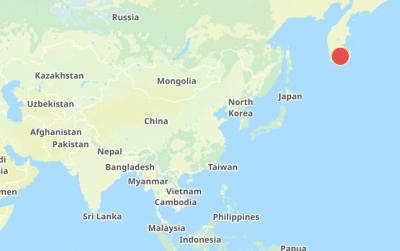The Council of Agriculture (COA) on Tuesday shared tips on how to differentiate a blue-ringed octopus from other species, after reports that someone might have purchased the venomous creature at a market in New Taipei City.
A person on a local Tamsui District (淡水) Facebook group last month posted a warning about their purchase from a neighborhood seafood vendor.
After bringing the batch of octopuses home, the poster realized that one looked different from the others and did not cook it.
The person was later told it was a blue-ringed octopus, a small but highly venomous species characterized by the neon blue rings that dot its body.
The story gained traction in local media, which also reported that it carries enough toxin in its small body to kill 26 people.
The vendor told reporters that since small edible octopuses are sold in batches, it was not noticed before the customer made the purchase.
Although it looks similar to other species when dead, the octopus can be identified by the blue rings on its body, the council said earlier this week.
When alive, the octopus has striking blue and black rings running along a yellowish body, it said, adding that the rings turn deep brown when it dies, making it harder to differentiate from other types.
Hwang Deng-fwu (黃登福), a professor at National Taiwan Ocean University’s marine toxins laboratory, said that blue-ringed octopuses are often mistakenly caught by fishers, as they are only about the size of a person’s thumb, adding that they easily arrive on market as they look similar to edible types of octopus.
Two people in Taiwan since 2020 have been sent to emergency rooms for accidentally eating a blue-ringed octopus, Hwang said.
Eating one or two is unlikely to result in lasting consequences, but three could be fatal, Hwang said, adding that eating one would likely cause the mouth, lips and tongue to go numb within a minute or two.
As ambulances in Taiwan usually deliver people to a hospital within half an hour, there is enough time for treatment while the body metabolizes the toxin, he said.
However, waiting until there is difficulty breathing to seek treatment would likely be too late, he added.
For instance, if a diver is bitten by one and cannot receive treatment for two or three hours, it could be fatal, although most divers are aware of the risk, he said.
Regarding the claim that one octopus could kill 26 people, National Museum of Natural Science Biology Department associate researcher Lee Kwen-shen (李坤瑄) said that it refers to the amount of venom it contains, which has the ability to completely paralyze a victim and make it difficult to breathe without medical assistance.
The waters around Taiwan have the same types of blue-ringed octopus found around the Philippines and Australian Great Barrier Reef, with venom that is just as potent, as well as two others that have yet to be analyzed, Lee said.

“China is preparing to invade Taiwan,” Deputy Minister of Foreign Affairs Francois Wu (吳志中) said in an exclusive interview with British media channel Sky News for a special report titled, “Is Taiwan ready for a Chinese invasion?” the Ministry of Foreign Affairs said today in a statement. The 25-minute-long special report by Helen Ann-Smith released yesterday saw Sky News travel to Penghu, Taoyuan and Taipei to discuss the possibility of a Chinese invasion and how Taiwan is preparing for an attack. The film observed emergency response drills, interviewed baseball fans at the Taipei Dome on their views of US President

The Central Weather Administration (CWA) today issued a "tsunami watch" alert after a magnitude 8.7 earthquake struck off the Kamchatka Peninsula in northeastern Russia earlier in the morning. The quake struck off the east coast of the Kamchatka Peninsula at 7:25am (Taiwan time) at a depth of about 19km, the CWA said, citing figures from the Pacific Tsunami Warning Center. The CWA's Seismological Center said preliminary assessments indicate that a tsunami could reach Taiwan's coastal areas by 1:18pm today. The CWA urged residents along the coast to stay alert and take necessary precautions as waves as high as 1m could hit the southeastern

ECONOMIC BENEFITS: The imports from Belize would replace those from Honduras, whose shrimp exports have dropped 67 percent since cutting ties in 2023 Maintaining ties with Taiwan has economic benefits, Ministry of Foreign Affairs officials said yesterday, citing the approval of frozen whiteleg shrimp imports from Belize by the Food and Drug Administration (FDA) as an example. The FDA on Wednesday approved the tariff-free imports from Belize after the whiteleg shrimp passed the Systematic Inspection of Imported Food, which would continue to boost mutual trade, the ministry said. Taiwan’s annual consumption of whiteleg shrimps stands at 30,000 tonnes, far exceeding domestic production, the ministry said. Taiwan used to fill the gap by importing shrimps from Honduras, but purchases slumped after Tegucigalpa severed diplomatic ties with Taiwan

The Executive Yuan yesterday approved a southwestern extension of the Sanying MRT Line from New Taipei to Bade District (八德) in Taoyuan, with a goal of starting construction by late 2026. The 4.03-kilometer extension, featuring three new stations, will run from the current terminus at Yingtao Fude Station (LB12) in New Taipei City to Dannan Station (LB14), where it will connect with Taoyuan’s Green Line, New Taipei City Metro Corp said in a statement. This extension will follow the completion of core Sanying Line, a 14.29-kilometer medium-capacity system linking Tucheng (土城), Sansia (三峽)